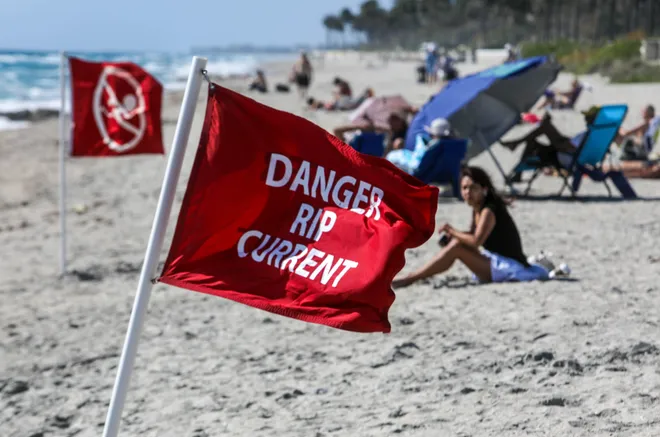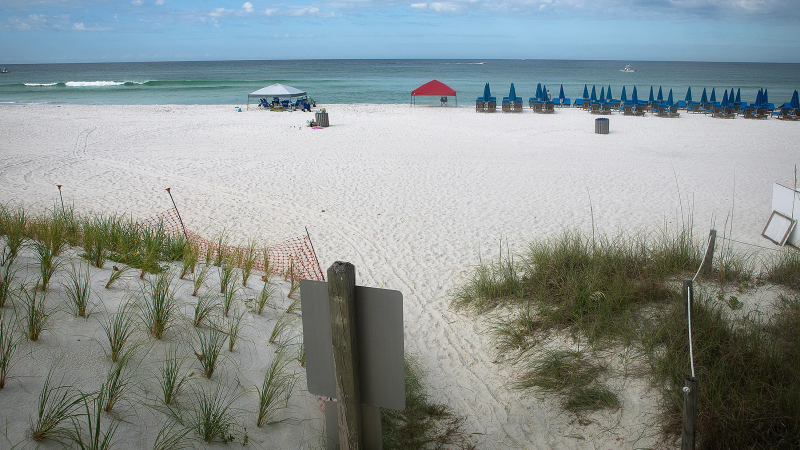Rip currents kill 4 in 48 hours: Panama City Beach on pace to be deadliest in US
Deadly rip currents off Panama City, Florida, killed four people within 48 hours, a tragic toll setting the area on pace for another year as one of the country's deadliest beaches.
The bodies of three young men were found, one by one, Friday evening, authorities said. They had traveled to Panama City from Alabama just a few hours earlier.
On Thursday afternoon, rescue officials attempted in vain to save a 19-year-old swimmer behind Sharky's Beachfront Restaurant in Panama City Beach.
In 2023, Panama City rip currents claimed more lives than anywhere else in the United States, according to National Weather Service data. At least eight people died there. Overall, Florida rip currents killed more than 30 people last year. That's compared to five who died in New Jersey and three each in California, South Carolina, and Louisiana.
The often busy beaches in the summer season carry a hidden danger: fast-moving channels of water that can drag a swimmer away from shore and exhaust them trying to fight their way out. The National Ocean Service estimates thousands of people are rescued from rip currents each year in the U.S.

While rip currents can happen at any beach with breaking waves, including at the Great Lakes, waters off the Florida coast have proven some of the most deadly. At least six people have died at Florida beaches this week alone, adding to 11 others who have drowned elsewhere in the U.S. and its territories due to rip currents this year through June 9.
Visitors killed in dangerous Florida rip currents
Drowning incidents at Florida beaches in the last few days have killed at least six people visiting from out of state.
Tragedy struck in Panama City on Friday, when three men visiting from Alabama drowned in the ocean while single red flags were flying, meaning conditions were hazardous with high surf or strong currents.
The men arrived in the area earlier in the afternoon, the Bay County Sheriff's Office said. Harold Denzel Hunter, 25; Jemonda Ray, 24; and Marius Richardson, 24; all from the Birmingham area, entered the water at about 8 p.m. They had checked in to stay at beachfront condominiums and were going to head out shopping but wanted to get in a swim first.
Just over 10 minutes later, the sheriff's office responded to a report of distressed swimmers. Other members of their party, women, were with them but came to shore before the men became distressed in the Gulf.
Hunter, Ray, and Richardson were found one by one within a half mile of where they had entered the water. They were taken to local hospitals, where they were pronounced dead.
On Thursday, a 19-year-old man visiting from Oklahoma was caught in a rip current and drowned off of Panama City Beach. Ryker Milton was in his first year of online seminary training and was shadowing the student pastor at New Community Church, a nondenominational Christian church, Lead Pastor Simeon Young told the Panama City News Herald, part of the USA TODAY Network.

A couple from Pennsylvania died Thursday after getting caught in a rip current off of Stuart Beach Hutchinson Island, officials said. Brian Warter, 51, and Erica Wishard, 48, were vacationing there with their six children when they and two of the teenaged children got caught in the rip current. The two teenagers were able to break free from the current.
Live updates3 young men drowned in Gulf of Mexico in Bay County Florida
SEE HOW RIP CURRENTS WORK:Graphics show how rip currents endanger swimmers
Rip currents claim dozens of lives every year
Last year, about 91 people died in rip currents at U.S. beaches, according to weather service data. That was up from the 10-year average of 74 deaths per year. Most people who drown in rip currents and other surf hazards are boys and men between the ages of 10 and 29, data shows, and most of the deaths happen in the months of June and July.
Experts say rip currents are so dangerous because they can cause a swimmer to panic and try to swim toward shore, causing fatigue before they are ever able to break free from the current, which is pulling them out.

Always check water conditions before you enter the ocean, officials say, and swim near a life guard. It is illegal in Florida to swim while there are double red flags displayed, which indicate the most hazardous conditions. Single red flags mean strong rip currents are expected, and it's recommended to stay out of the water.
Panama City beaches continue deadly record
Most Panama City Beach water rescues happen during single red flag conditions, Panama City Beach Fire Rescue Beach Safety Director Daryl Paul told the Panama City News Herald, part of the USA TODAY Network. Deadly rip currents can happen even when the surf seems calm, he said. Two deaths last year occurred under single red flags, while the seven others in Bay County happened with double red flags overhead during very rough surf conditions.
"Waves aren't killing people here. Waves aren't the hazard. It's rip currents that are the hazard, and that's what we're flying the flags for," Paul said.
If you get caught in a rip current, you should try to remain calm. Swim parallel to the shore instead of toward the shore, then swim back to land at an angle once you're free of the rip current.
Contributing: Claire Thornton and Dinah Voyles Pulver, USA TODAY; Nathan Cobb, Lianna Norman and C. A. Bridges, Panama City News Herald
Disclaimer: The copyright of this article belongs to the original author. Reposting this article is solely for the purpose of information dissemination and does not constitute any investment advice. If there is any infringement, please contact us immediately. We will make corrections or deletions as necessary. Thank you.

